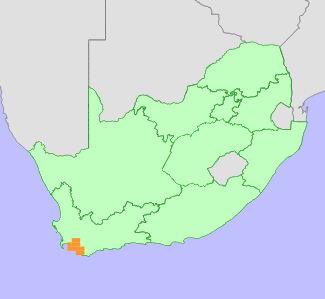|
Scientific Name | Serruria rubricaulis R.Br. |
Higher Classification | Dicotyledons |
Family | PROTEACEAE |
Common Names | Red-stem Spiderhead (e) |
National Status |
Status and Criteria | Vulnerable A4c |
Assessment Date | 2020/08/10 |
Assessor(s) | A.G. Rebelo, H. Mtshali & L. von Staden |
Justification | Serruria rubricaulis has a restricted distribution range, with an extent of occurrence (EOO) of 2735 km², and an area of occupancy (AOO) of 600 km². There is a continuing decline due to ongoing habitat loss and degradation. A population reduction of 33-38%, is inferred from the recent rate of habitat loss, projected to be met by 2070, over a period of less than three generations for this long-lived resprouter (generation length 50-100 years), which includes two generations in the past and one generation projected into the future. It therefore qualifies for listing as Vulnerable under criterion A. |
Distribution |
Endemism | South African endemic |
Provincial distribution | Western Cape |
Range | This species is endemic to the mountains of the Western Cape Province, South Africa, where it occurs from the Hottentots Holland to Kleinrivier Mountains. |
Habitat and Ecology |
Major system | Terrestrial |
Major habitats | South Sonderend Sandstone Fynbos, Overberg Sandstone Fynbos, Kogelberg Sandstone Fynbos, Hawequas Sandstone Fynbos, Elim Ferricrete Fynbos, Hangklip Sand Fynbos |
Description | It grows in sandstone fynbos at lower altitudes. It is a long-lived species (generation length 50-100 years), and survives fires by resprouting from underground boles or rootstocks. Seeds are released after ripening, and dispersed by ants to their underground nests, where they are protected from predation and fire. It is pollinated by insects. |
Threats |
| This species has lost its habitat to coastal development at Rooiels, Betty's Bay, Kleinmond, Fisherhaven and Hermanus. Currently, it is threatened by competition from alien invasive plants that are spreading and increasing in density in the Hawequas, Shaw's and Kleinrivier Mountains, as well as groundwater extraction in the Hottentots Holland and Kogelberg mountains.
It is also threatened by invasive ant species that are displacing native ant species. Invasive ants do not perform the function of indigenous ants, which is to bury this species' seeds in their nests where they are protected from fire. Large scale ant invasions could lead to a population collapse if there is no soil-stored seed bank to regenerate from post fire. |
Population |
This species occurs over a 76 km-long range from Gordon’s Bay to Papiesvlei. It has been heavily impacted by urban development in the past. It is still common on slopes above developments. Isolated plants occur in the Groenlandberg Mountains. Records from Stettynsberg and Riviersonderend should be investigated further.
This long-lived species (generation length 50-100 years) has already lost 24% of its habitat in the past two generations (100-200 years), and based on recent rates of habitat loss (1990-2014), a population reduction of 33-38% is expected to occur within three generations including two generations in the past, and one projected into the future.
|
Population trend | Decreasing |
Conservation |
| This species is conserved within the Kogelberg, Kleinmond Coast and Mountain, Houwhoek, Mt Hebron, Fernkloof, with outliers in Groenlandberg nature reserves. |
Assessment History |
Taxon assessed |
Status and Criteria |
Citation/Red List version | | Serruria rubricaulis R.Br. | NT A2c | Raimondo et al. (2009) | |
Bibliography |
Goldblatt, P. and Manning, J.C. 2000. Cape Plants: A conspectus of the Cape Flora of South Africa. Strelitzia 9. National Botanical Institute, Cape Town.
Manning, J.C. and Goldblatt, P. 2012. Plants of the Greater Cape Floristic Region 1: The Core Cape Flora. Strelitzia 29. South African National Biodiversity Institute, Pretoria.
Raimondo, D., von Staden, L., Foden, W., Victor, J.E., Helme, N.A., Turner, R.C., Kamundi, D.A. and Manyama, P.A. 2009. Red List of South African Plants. Strelitzia 25. South African National Biodiversity Institute, Pretoria.
Rebelo, T. 2001. Sasol Proteas: A field guide to the proteas of southern Africa. (2nd ed.). Fernwood Press, Vlaeberg, Cape Town.
|
Citation |
| Rebelo, A.G., Mtshali, H. & von Staden, L. 2020. Serruria rubricaulis R.Br. National Assessment: Red List of South African Plants version 2024.1. Accessed on 2025/12/02 |
 Comment on this assessment
Comment on this assessment

